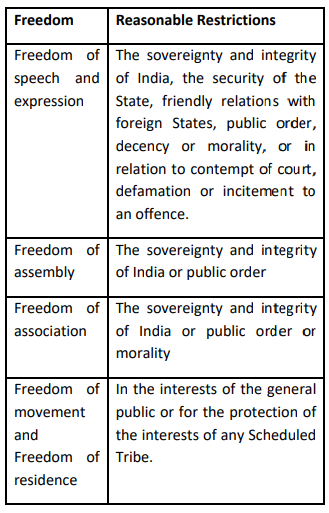Question
Consider the following statement(s) about “Article
19” of the Indian Constitution: 1. These rights are protected only against the State and not against private individuals. 2. Reasonable restrictions can be put on all the freedoms on the grounds of public order, decency or morality, contempt of court, defamation and incitement of an offence. 3. No objection can be made when the State carries on a trade, business, industry or service either as a monopoly to the exclusion of citizens. Which of the above statement(s) is/are correct?Solution
● Statement 1 is correct - These rights are protected only against the State and not against private individuals. ● Statement 2 is incorrect – Article 19 itself defines the reasonable restrictions imposed on the rights provided under this Article. These are:  • Statement 3 is correct- Article 19(6) provides exception to Article 19(1)(g) that No objection can be made when the State carries on a trade, business, industry or service either as a monopoly (complete or partial) to the exclusion of citizens (all or some only) or in competition with any citizen.
• Statement 3 is correct- Article 19(6) provides exception to Article 19(1)(g) that No objection can be made when the State carries on a trade, business, industry or service either as a monopoly (complete or partial) to the exclusion of citizens (all or some only) or in competition with any citizen.
Securities with the combination of characteristics of debt and equity securities are known as
All single payment transactions of Rs. ______ crore and above undertaken by entities (non-individuals) should include remitter and beneficiary LEI infor...
The National Payments Corporation of India (NPCI) is an initiative taken by the _________________ to operate the retail payments and settlement systems ...
Match the following:
A) Authorised Capital P) for which company has received applications
B) Subscribed capital Q) Now shareholders
‘Goods in transit’ sent from Head Office are shown in the balance sheet at –
If Current Assets are 50,000 and Creditors is 7,000 and the Bank overdraft is 5,000, what will be figure of the Working Capital?
In case of a 'put option' when the strike price is above the spot price, the option is -
When RBI raises the Cash reserve Ratio rate what action are the banks required to take?
Which of the market can be divided into primary and secondary market?
Which institution is the most important constituent of Indian money market?
Relevant for Exams:



